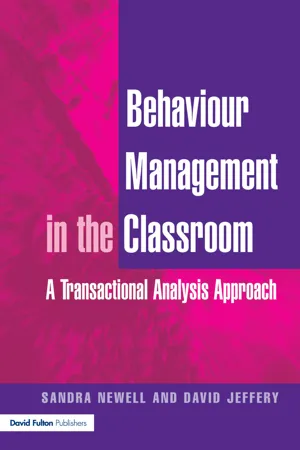
Behaviour Management in the Classroom
A Transactional Analysis Approach
- 160 pages
- English
- ePUB (mobile friendly)
- Available on iOS & Android
About this book
Ask any trainee teacher, or indeed experienced teacher, which aspect of teaching concerns them most and they will probably say "getting pupils to behave."
This book looks at the relationships between teachers and pupils in the classroom. It explores ways of using the ideas in Transactional Analysis to create win-win situations in the classroom, making a more pleasant and productive atmosphere for all concerned. It offers teachers practical examples of how to model behavior, structure time, use contracts and praise pupils in order to avoid or resolve conflict quickly and fairly so that everyone feels OK and learning is put at the forefront.
The authors both have extensive experience of teaching and managing behavior and have much to offer in terms of guidance for managing your classes successfully. The book provides a simple introduction to and explanations of aspects of the theory; lots of practical examples, strategies and suggestions; reflections and activities; and bullet-pointed summaries at the end of each chapter.
Frequently asked questions
- Essential is ideal for learners and professionals who enjoy exploring a wide range of subjects. Access the Essential Library with 800,000+ trusted titles and best-sellers across business, personal growth, and the humanities. Includes unlimited reading time and Standard Read Aloud voice.
- Complete: Perfect for advanced learners and researchers needing full, unrestricted access. Unlock 1.4M+ books across hundreds of subjects, including academic and specialized titles. The Complete Plan also includes advanced features like Premium Read Aloud and Research Assistant.
Please note we cannot support devices running on iOS 13 and Android 7 or earlier. Learn more about using the app.
Information
Part 1
What is Transactional Analysis?
Chapter 1
Introduction to Transactional Analysis
- a theory of personality (using a three-part model known as the ‘ego-state model’)
- a theory of communication or interpersonal behaviour (using the ideas of transactions)
- a theory of child development (using the idea of a life script).
- Life Positions
- Strokes
- Contracts
- Ego States
- Transactions
- Life Scripts
- Games
- Discounting.
Chapter 2
Philosophical Assumptions in TA
- People are OK.
- Everyone has the capacity to think.
- People decide their own destiny and these decisions can be changed.
ASSUMPTION 1: PEOPLE ARE OK
- bullies or name callers
- aggressive
- hyperactive
- unable to work with other pupils or share materials
- passive or victims
- withdrawing loners who find it difficult to get on with other pupils
- fearful, stressful pupils
- painfully self-conscious.
- have a healthy respect for themselves and others
- are aware of their behaviour and have a sense of fairness
- are aware of the needs of others and will accept other pupils’ ideas, share materials and apologise when necessary
- have an ability to encourage, praise and help other pupils
- have the confidence to try out new things
- show a desire to do their best
- are assertive, rather than aggressive.
- firm but fair
- not biased
- respects pupils
- is a good role model
- works hard
- gets involved
- takes an interest in the pupils as individuals
- is patient and calm
- is willing to listen
- understands and cares
- has a good personality
- is enthusiastic
- has a good sense of humour
- treats pupils as human beings
- is never sarcastic
- never puts you down.
ASSUMPTION 2: EVERYONE HAS THE CAPACITY TO THINK
ASSUMPTION 3: PEOPLE DECIDE THEIR OWN DESTINY AND THESE DECISIONS CAN BE CHANGED
Chapter 3
Life Positions
… one’s basic beliefs about self and others, which are used to justify decisions and behaviour.(Steiner, 1974)
- I’m OK, you’re OK This is the position that is most healthy and the one teachers should aim to promote because this Life Position will help to create a relationship of mutual respect. Conflict is also less likely. Pupils who adopt this position consider themselves valued and respect other people.
- I’m OK, you’re not OK Teachers who adopt this position will not show respect for pupils. Conflict is likely to develop because pupils will be aware of this. The teacher may blame the pupils for everything that goes wrong in the classroom and be unprepared to change their own behaviour in order to improve the situation. Pupils who adopt this position will be over-critical and may accuse the teacher of picking on them.
- I’m not OK, you’re OK Teachers adopting this position are likely to be highly self-critical and convinced that they are not doing a good job. They may underestimate their own ability, while promoting that of other colleagues. Pupils adopting this position are likely to be withdrawn, consider themselves stupid or useless and put themselves down all the time. They may also experience shame and in this ‘down’ position, they are unlikely to learn.
- I’m not OK, you’re not OK This is the most negative Life Position, both for teachers and for pupils. Teachers are self-critical and are negative towards pupils. Pupils put themselves down and blame teachers for their lack of success.
ACTIVITY
ACTIVITY
Table of contents
- Cover Page
- Half Title page
- Title Page
- Copyright Page
- Contents
- Foreword
- Preface
- About the Authors
- Acknowledgements
- List of Figures
- Introduction
- Part 1 What is Transactional Analysis?
- Part 2 Developing Relationships in the Classroom
- Part 3 Structuring the Lesson
- Part 4 Maintaining Relationships in the Classroom
- Part 5 Staying OK
- Appendix 1 Class Contract
- Appendix 2 Behaviour Contract
- Appendix 3 Certificates
- Appendix 4 Letter to Parents
- Glossary of TA Terminology
- Further Reading
- Bibliography